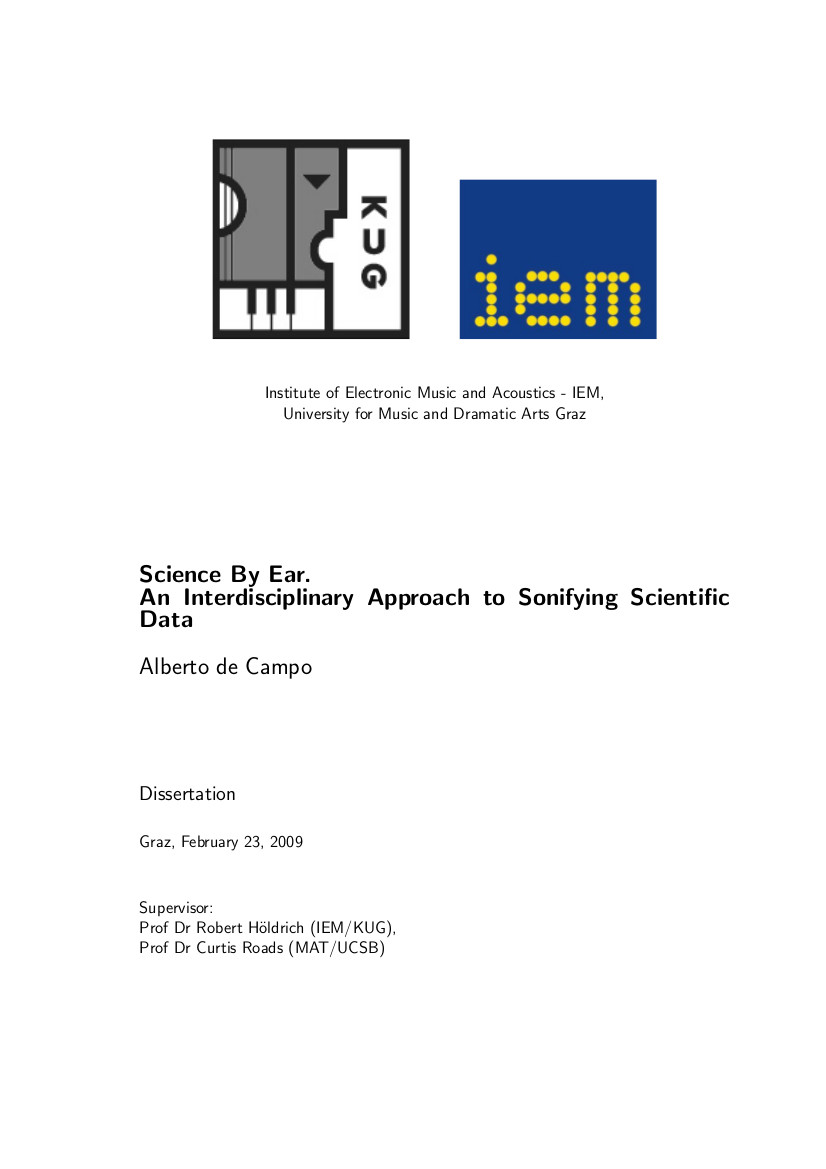Trevor Pinch, Karin Bijsterveld (eds.): The Oxford Handbook of Sound Studies (2011)
Filed under book | Tags: · acoustics, computing, data visualisation, electronic music, field recording, game studies, hip hop, listening, medicine, music, noise, perception, phonograph, radio, science, sonification, sound, sound design, sound recording, sound studies, vision

“Written by the leading scholars and researchers in the emerging field of sound studies, The Oxford Handbook of Sound Studies offers new and fully engaging perspectives on the significance of sound in its material and cultural forms. The book considers sounds and music as experienced in such diverse settings as shop floors, laboratories, clinics, design studios, homes, and clubs, across an impressively broad range of historical periods and national and cultural contexts.
Science has traditionally been understood as a visual matter, a study which has historically been undertaken with optical technologies such as slides, graphs, and telescopes. This book questions that notion powerfully by showing how listening has contributed to scientific practice. Sounds have always been a part of human experience, shaping and transforming the world in which we live in ways that often go unnoticed. Sounds and music, the authors argue, are embedded in the fabric of everyday life, art, commerce, and politics in ways which impact our perception of the world. Through an extraordinarily diverse set of case studies, authors illustrate how sounds — from the sounds of industrialization, to the sounds of automobiles, to sounds in underwater music and hip-hop, to the sounds of nanotechnology — give rise to new forms listening practices. In addition, the book discusses the rise of new public problems such as noise pollution, hearing loss, and the “end” of the amateur musician that stem from the spread and appropriation of new sound- and music-related technologies, analog and digital, in many domains of life.”
Publisher Oxford University Press, 2011
ISBN 0199995818, 9780195388947
624 pages
Reviews: John F. Barber (Leonardo, 2012), Bruce Johnson (Popular Music, 2013), William Cheng (Journal of the American Musicological Society, 2014).
Comment (0)Jonathan Crary: Techniques of the Observer: On Vision and Modernity in the Nineteenth Century (1990–) [EN, HU, TR, ES, BR-PT, CN]
Filed under book | Tags: · 1800s, art, art history, body, camera obscura, image, knowledge, optics, painting, perception, perspective, representation, science, space, vision

“In Techniques of the Observer Jonathan Crary provides a dramatically new perspective on the visual culture of the nineteenth century, reassessing problems of both visual modernism and social modernity.
Inverting conventional approaches, Crary considers the problem of visuality not through the study of art works and images, but by analyzing the historical construction of the observer. He insists that the problems of vision are inseparable from the operation of social power and examines how, beginning in the 1820s, the observer became the site of new discourses and practices that situated vision within the body as a physiological event. Alongside the sudden appearance of physiological optics, Crary points out, theories and models of “subjective vision” were developed that gave the observer a new autonomy and productivity while simultaneously allowing new forms of control and standardization of vision.
Crary examines a range of diverse work in philosophy, in the empirical sciences, and in the elements of an emerging mass visual culture. He discusses at length the significance of optical apparatuses such as the stereoscope and of precinematic devices, detailing how they were the product of new physiological knowledge. He also shows how these forms of mass culture, usually labeled as “realist,” were in fact based on abstract models of vision, and he suggests that mimetic or perspectival notions of vision and representation were initially abandoned in the first half of the nineteenth century within a variety of powerful institutions and discourses, well before the modernist painting of the 1870s and 1880s.”
Publisher MIT Press, Dec 1990
October Books series
ISBN 0262031698
171 pages
Publisher (EN)
Techniques of the Observer: On Vision and Modernity in the Nineteenth Century (English, 1990, 21 MB, updated on 2015-2-18)
A megfigyelő módszerei. Látás és modernitás a 19. században (Hungarian, trans. Ágnes Lukács, 1999, no OCR)
Gözlemcinin Teknikleri. On Dokuzuncu Yüzyılda Görme ve Modernite (Turkish, trans. Elif Daldeniz, 2002/2004, added on 2024-3-3)
Las técnicas del observador: visión y modernidad en el siglo XIX (Spanish, trans. Fernando López García, 2008)
Técnicas do observador: visão e modernidade no século XIX (BR-Portuguese, trans. Verrah Chamma, 2012, added on 2024-3-3)
Guan cha zhe de ji shu / 观察者的技术 (Chinese, 2017, added on 2024-3-3)
Alberto de Campo: Science by Ear: An Interdisciplinary Approach to Sonifying Scientific Data (2009)
Filed under thesis | Tags: · perception, software, sonification, sound

Sonification of Scientific Data is intrinsically interdisciplinary: It requires collaboration between experts in the respective scientific domains, in psychoacoustics, in artistic design of synthetic sound, and in working with appropriate programming environments. The SonEnvir project hosted at IEM Graz put this view into practice: in four domain sciences, sonification designs for current research questions were realised.
This dissertation contributes to sonification research in three aspects:
The body of sonification designs realised within the SonEnvir context is described, which may be reused in sonification research in different ways.
The software framework built with and for these sonification designs is presented, which supports fluid experimentation with evolving sonification designs.
A theoretical model for sonification design work, the Sonification Design Space Map, was synthesised based the analysis of this body of sonification designs (and a few selected others). This model allows systematic reasoning about the process of creating sonification designs, and provides concepts for analysing and categorising existing sonifications designs more systematically.
Dissertation
Institute of Electronic Music and Acoustics – IEM, University for Music and Dramatic Arts Graz, February 2009
Supervisors: Robert Höldrich, Curtis Roads
211 pages
SonEnvir research project
PDF
View online (on Scribd.com, from the author)

